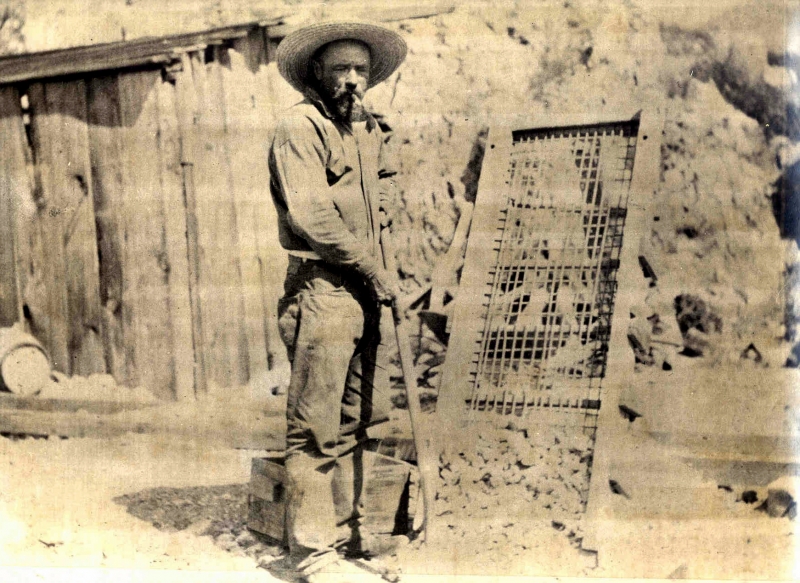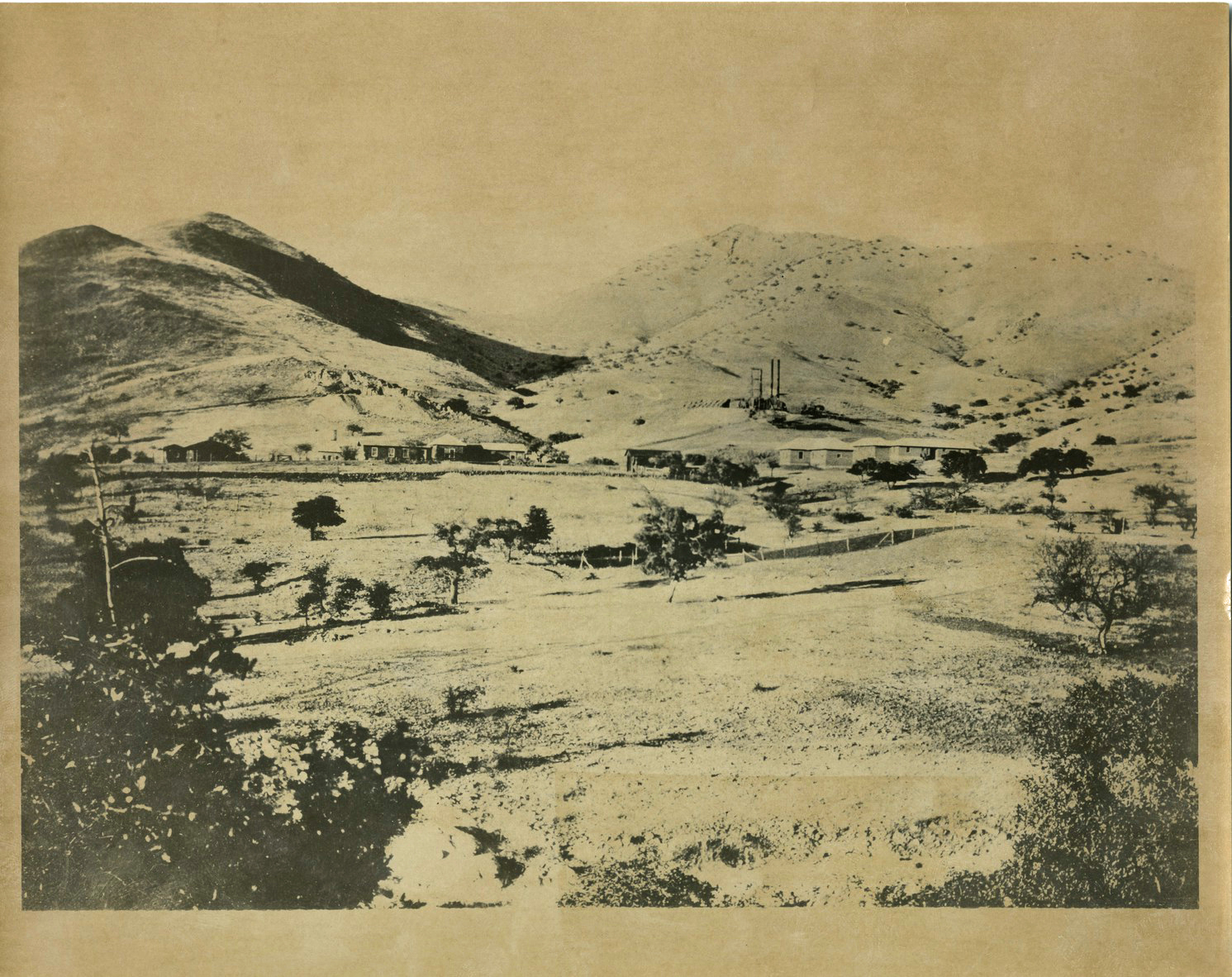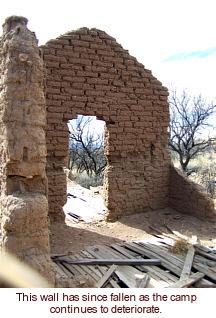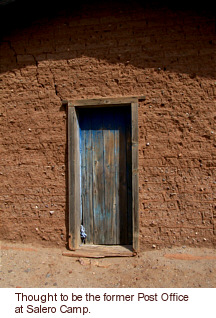
|
|
|
Mines Map
Use the links at the left to return.
|
|
Mine Descriptions |
|
Salero Mine | |
|
Alternate NamesDarwin, Constitution1 CompaniesWrightson Bros., Salero Mg. Co., Clark & Peterson, Weir, Salero Mines Co., Sortilion, Discovery Process Inc.1 LocationSalero Mine
Salero Camp
Additional information can be found in the AZGS correspondence files at: http://docs.azgs.az.gov/OnlineAccessMineFiles/S-Z/SaleromineSantacruz86a.pdf Location: 21S 14E NE¼251 Mining District and MinesTyndall District Pb, Ag, Cu-, Zn-, Au-1 Shaft operations. one of the oldest mines of the district, worked by Jesuit and Franciscan missionaries and early Americans prior to the 1900 and only on a small scale since then. Total production would be 500 tons of ore averaging about 12% Pb, 24 oz. Ag/T, less than 1% Cu and Zn, and minor Au.1 Visited site 1/29/23 but it was renced off and inaccessible.10 Description by Richard A. Zidonis WebZar.com, Inc. [Authors note: The Ghost Town of Salero Camp is located on private property within the confines of Salero Ranch.] The Salero Mining Company acquired the Salero Mine in 1857. The company was organized by William Wrightson of the Cincinnati Enquirer, but such notables as H. C. Grosvenor, an English mining engineer, Gilbert Hopkins, mineralogist and engineer, Raphael Pumpelly, geologist, engineer, author and later a professor at Harvard, were associated with the company. It was headquartered in Tubac from 1858 to 1861. Raphael Pumpelly was brought in to try to put the Salero on a paying basis. Unfortunately, at that time, this portion of Arizona was the domain of the Apache Indians who murdered whites working and living in the area, stole their cattle and destroyed most anything that could be destroyed. Such an incident caused the demise of operations for the Salero Mining Company at Salero Mine. A wagonload of ore being delivered to the Salero mine in payment for an intracompany debt was ambushed by Apaches just outside the camp. Horace C. Grosvenor was among those murdered in this attack. With the entire countryside under siege, the Salero crew, under the direction of Pumpelly and behind armed guards, picked up the ore and smelted it, working day and night to do so. They then delivered the silver ingots to the company headquarters in Tubac. Sensing the seriousness of the situation, Poston, Pumpelly and others, escaped to California through the Sonoran desert. Mount Wrightson in the Santa Ritas was named for William Wrightson, manager of the Salero Mining Company. Mount Hopkins, also in the Santa Ritas, was named for Gilbert Hopkins. [Both were killed by Apaches] About 1875 the Salero Mining Company was reorganized as the Salero Mining and Manufacturing Company under the direction of Henry Wells. Wells had just stepped down as president of the American Express Company and earlier was one of the founders of the Wells Fargo Company. Wells was one of many New York financiers intrigued by the western mines. After 1876 the mine was known for a short time as the Darwin mine and later as the Constitution mine. Salero Camp's post office was established August 13, 1884 and was discontinued April 17, 1890. About 1898 Peterson & Clark drove a 300 foot shaft in exploration for new ore, and they sold the mine to a new group known as the Salero Mines Company with involvement by William Phipps Blake, one of the country's leading mining engineers. Limited production, continued through at least 1920. The Ghost Town's proper name is Salero Camp, and it is located just south of the Salero Mine. The mine started as a 75 foot deep shaft with some drifts. Drifts are defined as horizontal passages that follow the vein. Crosscuts are defined as horizontal passages that intersect the vein. A later shaft at 300 feet deep was sunk by Mr. Weir. A new shaft was started in 1904, and it was later enlarged to a 2 compartment shaft in 1908. What remains today are the two shafts, 441 feet apart, with drifts and crosscuts combining into about 2,000 feet of workings. The east or Darwin shaft is a double-compartment shaft sunk to 400 feet, with drifts running 150 feet to the east and west with crosscuts spaced 25 feet apart. The old, or west, shaft sunk to 300 feet, has 150 feet of drifts on the 100 foot level and 200 feet of drifts on the 160 level.7 ProcessingSalero Camp: a smelter in the 1850s and 1860s.9 GeologyStrong quartz-fissure zone with veins of crushed, druzy, laminated quartz containing spotty argentite, chalcopyrite, minor galena and some pyromorphite in sheeted and fractured Cretaceous rhyodacite tuff and Laramide diorite. Strong and deep oxidation produced cerargyrite, lead chloride, iron and managanese staining, and copper carbonites in upper part.1 References
|
















